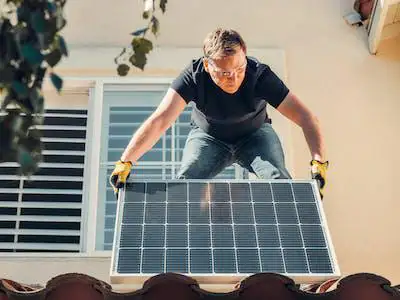Built to Brave the Elements:
Rest assured, solar roofs are engineered to be remarkably resilient. Unlike their traditional panel counterparts that sit atop existing roofs, solar roofs function as the actual roof covering, offering several key advantages in terms of durability and weather resistance:
Tempered Glass Shield: The outermost layer of most solar roofs is composed of tempered glass, a material renowned for its strength and impact resistance. This fortified barrier can withstand hailstorms, heavy snowfall, and even falling debris with minimal damage.
Protective Encapsulation: Beneath the glass lies a layer of polymer encapsulant, safeguarding the sensitive photovoltaic cells within. This encapsulant ensures waterproofing, preventing moisture infiltration and subsequent electrical disruptions.
Weatherproof Backing: The bottom layer of a solar roof typically comprises a weatherproof backsheet, often crafted from aluminum or a high-performance polymer. This layer provides additional protection against moisture, wind, and temperature fluctuations.
Seamless Integration: Unlike traditional panels attached to the roof with racking systems, solar roofs interlock seamlessly with the underlying structure. This eliminates potential weak points and provides a unified, weathertight barrier.
Tested and Certified for Toughness:
To ensure their ability to withstand diverse weather conditions, solar roofs undergo rigorous testing procedures established by international organizations like Underwriters Laboratories (UL) and the International Electrotechnical Commission (IEC). These tests assess performance under:
Extreme Temperatures: Solar roofs must remain functional in both scorching heat and frigid cold, often exceeding temperature ranges experienced in most climates.
High Winds: They are subjected to simulated wind speeds exceeding hurricane-force to guarantee stability and prevent wind uplift.
Hail Impact: Tests involve pelting the roofs with hailstone-sized projectiles to assess their ability to resist punctures and cracks.
Snow Loading: For regions prone to heavy snowfall, roofs are tested to ensure they can bear the weight of accumulated snow without deformation or structural compromise.
Beyond Resilience: Additional Advantages:
The weather resistance of solar roofs extends beyond simply enduring the elements. Here are some additional benefits:
Fire Resistance: Many solar roof materials possess inherent fire-retardant properties, offering an extra layer of safety for your home.
Reduced Roof Maintenance: By replacing your existing roof with a solar roof, you eliminate the need for separate roof maintenance and repairs, saving you time and money in the long run.
Enhanced Durability: Solar roofs often boast lifespans exceeding traditional asphalt shingle roofs, providing long-term protection and value for your investment.
Considerations and Caveats:
While solar roofs excel in weather resistance, a few factors warrant consideration:
Installation Quality: Proper installation by qualified professionals is crucial for ensuring optimal weatherproofing and performance.
Material Choice: Different solar roof materials offer varying degrees of weather resistance. Consult with experts to choose the best option for your specific climate and environmental conditions.
Local Building Codes: Ensure your chosen solar roof complies with local building codes and regulations regarding wind, snow, and seismic loads.
Investing in Peace of Mind:
With their robust construction, rigorous testing, and numerous advantages, solar roofs offer exceptional durability and weather resistance. They not only harness the power of the sun but also provide a sturdy and reliable shield for your home, come rain or shine, snow or hail. By choosing a high-quality solar roof and ensuring proper installation, you can invest in peace of mind, knowing your home is protected while generating clean, renewable energy for years to come.
Additional Resources:
National Renewable Energy Laboratory (NREL): https://www.nrel.gov/
Solar Energy Industries Association (SEIA): https://www.seia.org/
International Renewable Energy Agency (IRENA): https://www.irena.org/
I hope this information helps! Let me know if you have any other questions.

